Corporate Accounting: Comparing Measurement Methods Report
VerifiedAdded on 2022/09/07
|6
|1078
|30
Report
AI Summary
This report delves into two contrasting measurement methods in corporate accounting: fair value and historical cost. It defines fair value as the current market price of assets and liabilities, emphasizing its role in reflecting current market conditions and the absence of seller intent in determining the value. Conversely, historical cost is presented as the original purchase price of an asset, which is recorded and reported at the same amount in the balance sheet, irrespective of market fluctuations. The report examines the conceptual structures of both methods, highlighting the key elements like market conditions, intent, orderly transactions, and third parties for fair value and original cost for historical cost. It then discusses the situations where each method is preferable, emphasizing fair value's suitability for global business operations and historical cost's simplicity for small to medium-sized enterprises. The report concludes with a list of relevant references.
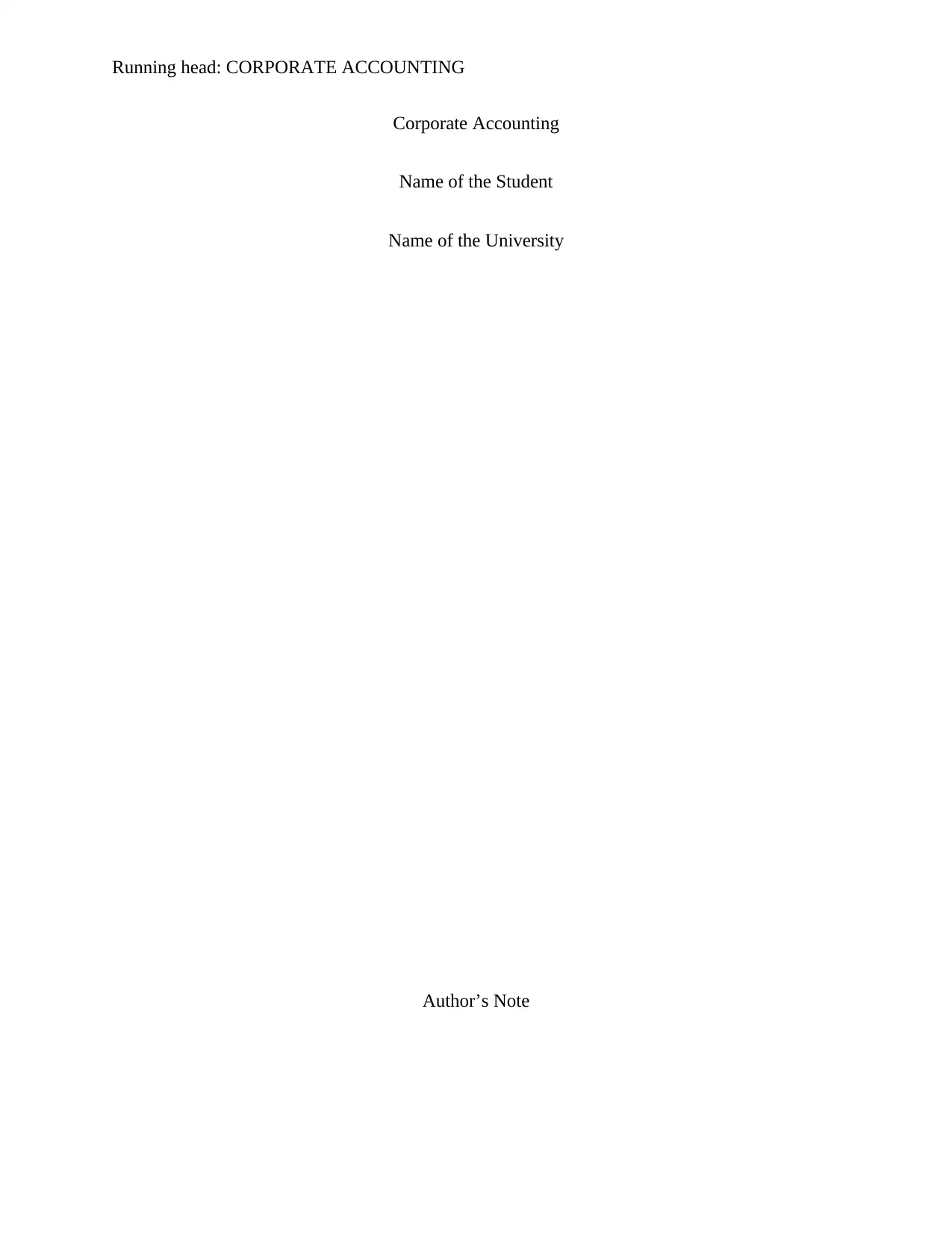
Running head: CORPORATE ACCOUNTING
Corporate Accounting
Name of the Student
Name of the University
Author’s Note
Corporate Accounting
Name of the Student
Name of the University
Author’s Note
Paraphrase This Document
Need a fresh take? Get an instant paraphrase of this document with our AI Paraphraser
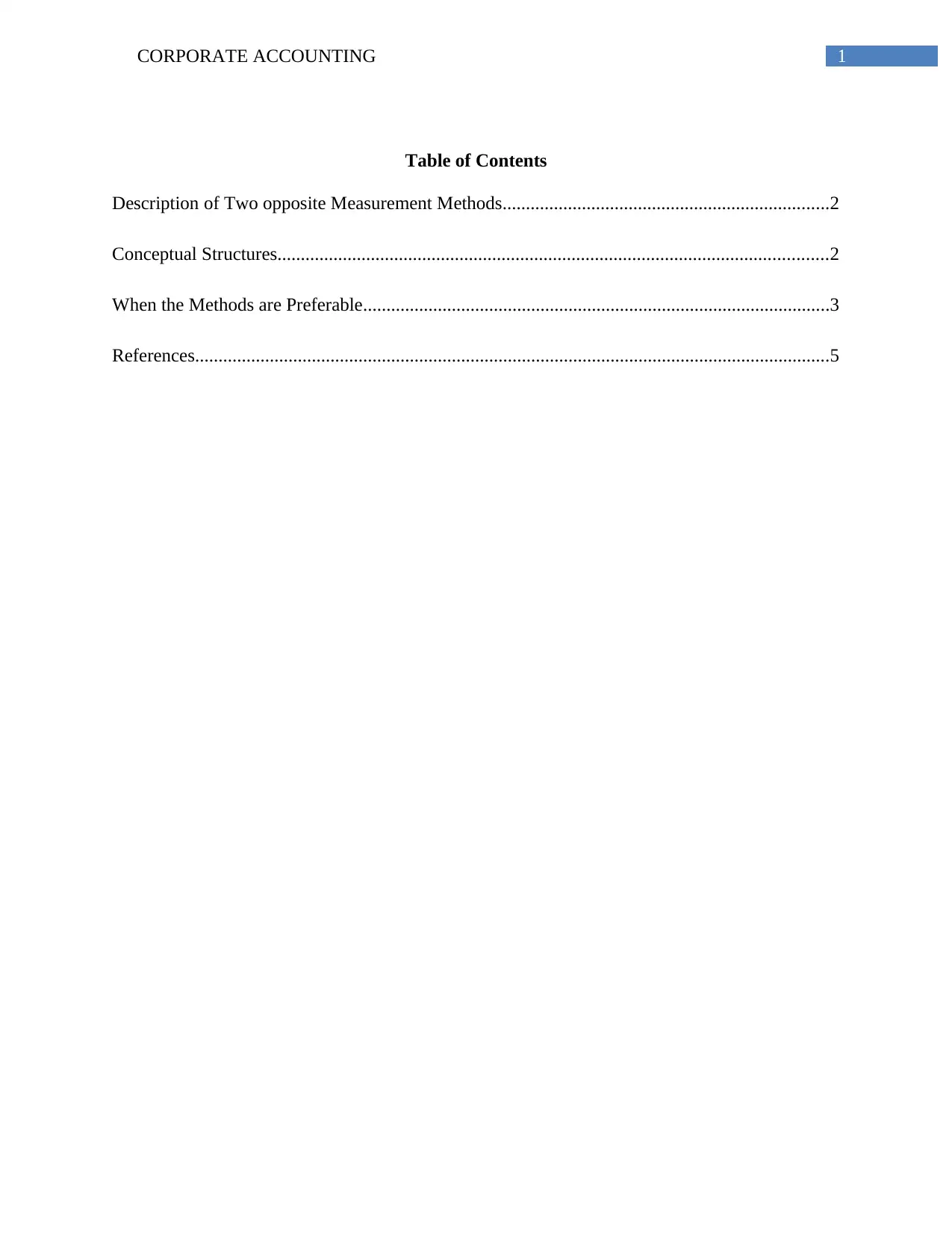
1CORPORATE ACCOUNTING
Table of Contents
Description of Two opposite Measurement Methods......................................................................2
Conceptual Structures......................................................................................................................2
When the Methods are Preferable....................................................................................................3
References........................................................................................................................................5
Table of Contents
Description of Two opposite Measurement Methods......................................................................2
Conceptual Structures......................................................................................................................2
When the Methods are Preferable....................................................................................................3
References........................................................................................................................................5
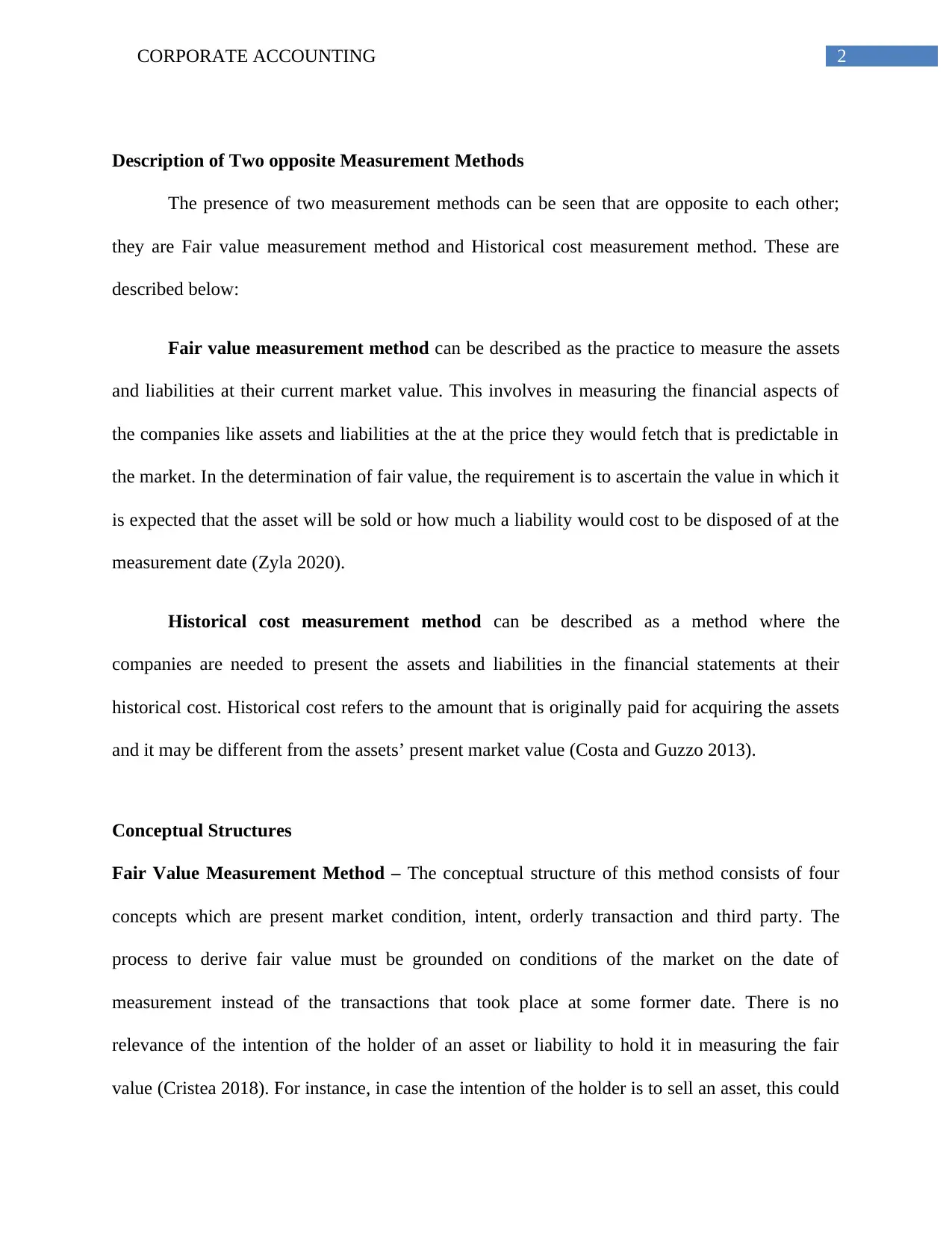
2CORPORATE ACCOUNTING
Description of Two opposite Measurement Methods
The presence of two measurement methods can be seen that are opposite to each other;
they are Fair value measurement method and Historical cost measurement method. These are
described below:
Fair value measurement method can be described as the practice to measure the assets
and liabilities at their current market value. This involves in measuring the financial aspects of
the companies like assets and liabilities at the at the price they would fetch that is predictable in
the market. In the determination of fair value, the requirement is to ascertain the value in which it
is expected that the asset will be sold or how much a liability would cost to be disposed of at the
measurement date (Zyla 2020).
Historical cost measurement method can be described as a method where the
companies are needed to present the assets and liabilities in the financial statements at their
historical cost. Historical cost refers to the amount that is originally paid for acquiring the assets
and it may be different from the assets’ present market value (Costa and Guzzo 2013).
Conceptual Structures
Fair Value Measurement Method – The conceptual structure of this method consists of four
concepts which are present market condition, intent, orderly transaction and third party. The
process to derive fair value must be grounded on conditions of the market on the date of
measurement instead of the transactions that took place at some former date. There is no
relevance of the intention of the holder of an asset or liability to hold it in measuring the fair
value (Cristea 2018). For instance, in case the intention of the holder is to sell an asset, this could
Description of Two opposite Measurement Methods
The presence of two measurement methods can be seen that are opposite to each other;
they are Fair value measurement method and Historical cost measurement method. These are
described below:
Fair value measurement method can be described as the practice to measure the assets
and liabilities at their current market value. This involves in measuring the financial aspects of
the companies like assets and liabilities at the at the price they would fetch that is predictable in
the market. In the determination of fair value, the requirement is to ascertain the value in which it
is expected that the asset will be sold or how much a liability would cost to be disposed of at the
measurement date (Zyla 2020).
Historical cost measurement method can be described as a method where the
companies are needed to present the assets and liabilities in the financial statements at their
historical cost. Historical cost refers to the amount that is originally paid for acquiring the assets
and it may be different from the assets’ present market value (Costa and Guzzo 2013).
Conceptual Structures
Fair Value Measurement Method – The conceptual structure of this method consists of four
concepts which are present market condition, intent, orderly transaction and third party. The
process to derive fair value must be grounded on conditions of the market on the date of
measurement instead of the transactions that took place at some former date. There is no
relevance of the intention of the holder of an asset or liability to hold it in measuring the fair
value (Cristea 2018). For instance, in case the intention of the holder is to sell an asset, this could
⊘ This is a preview!⊘
Do you want full access?
Subscribe today to unlock all pages.

Trusted by 1+ million students worldwide
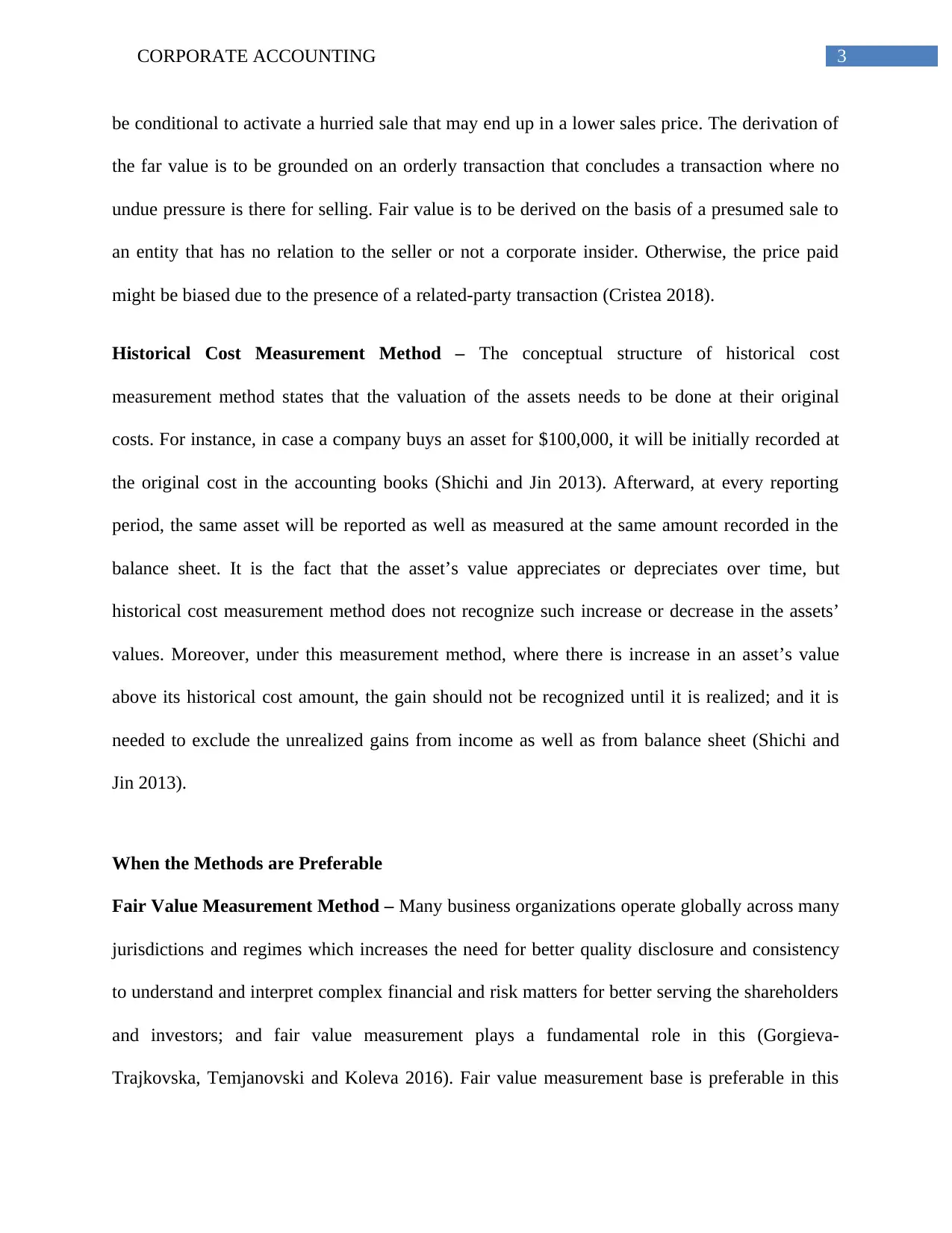
3CORPORATE ACCOUNTING
be conditional to activate a hurried sale that may end up in a lower sales price. The derivation of
the far value is to be grounded on an orderly transaction that concludes a transaction where no
undue pressure is there for selling. Fair value is to be derived on the basis of a presumed sale to
an entity that has no relation to the seller or not a corporate insider. Otherwise, the price paid
might be biased due to the presence of a related-party transaction (Cristea 2018).
Historical Cost Measurement Method – The conceptual structure of historical cost
measurement method states that the valuation of the assets needs to be done at their original
costs. For instance, in case a company buys an asset for $100,000, it will be initially recorded at
the original cost in the accounting books (Shichi and Jin 2013). Afterward, at every reporting
period, the same asset will be reported as well as measured at the same amount recorded in the
balance sheet. It is the fact that the asset’s value appreciates or depreciates over time, but
historical cost measurement method does not recognize such increase or decrease in the assets’
values. Moreover, under this measurement method, where there is increase in an asset’s value
above its historical cost amount, the gain should not be recognized until it is realized; and it is
needed to exclude the unrealized gains from income as well as from balance sheet (Shichi and
Jin 2013).
When the Methods are Preferable
Fair Value Measurement Method – Many business organizations operate globally across many
jurisdictions and regimes which increases the need for better quality disclosure and consistency
to understand and interpret complex financial and risk matters for better serving the shareholders
and investors; and fair value measurement plays a fundamental role in this (Gorgieva-
Trajkovska, Temjanovski and Koleva 2016). Fair value measurement base is preferable in this
be conditional to activate a hurried sale that may end up in a lower sales price. The derivation of
the far value is to be grounded on an orderly transaction that concludes a transaction where no
undue pressure is there for selling. Fair value is to be derived on the basis of a presumed sale to
an entity that has no relation to the seller or not a corporate insider. Otherwise, the price paid
might be biased due to the presence of a related-party transaction (Cristea 2018).
Historical Cost Measurement Method – The conceptual structure of historical cost
measurement method states that the valuation of the assets needs to be done at their original
costs. For instance, in case a company buys an asset for $100,000, it will be initially recorded at
the original cost in the accounting books (Shichi and Jin 2013). Afterward, at every reporting
period, the same asset will be reported as well as measured at the same amount recorded in the
balance sheet. It is the fact that the asset’s value appreciates or depreciates over time, but
historical cost measurement method does not recognize such increase or decrease in the assets’
values. Moreover, under this measurement method, where there is increase in an asset’s value
above its historical cost amount, the gain should not be recognized until it is realized; and it is
needed to exclude the unrealized gains from income as well as from balance sheet (Shichi and
Jin 2013).
When the Methods are Preferable
Fair Value Measurement Method – Many business organizations operate globally across many
jurisdictions and regimes which increases the need for better quality disclosure and consistency
to understand and interpret complex financial and risk matters for better serving the shareholders
and investors; and fair value measurement plays a fundamental role in this (Gorgieva-
Trajkovska, Temjanovski and Koleva 2016). Fair value measurement base is preferable in this
Paraphrase This Document
Need a fresh take? Get an instant paraphrase of this document with our AI Paraphraser
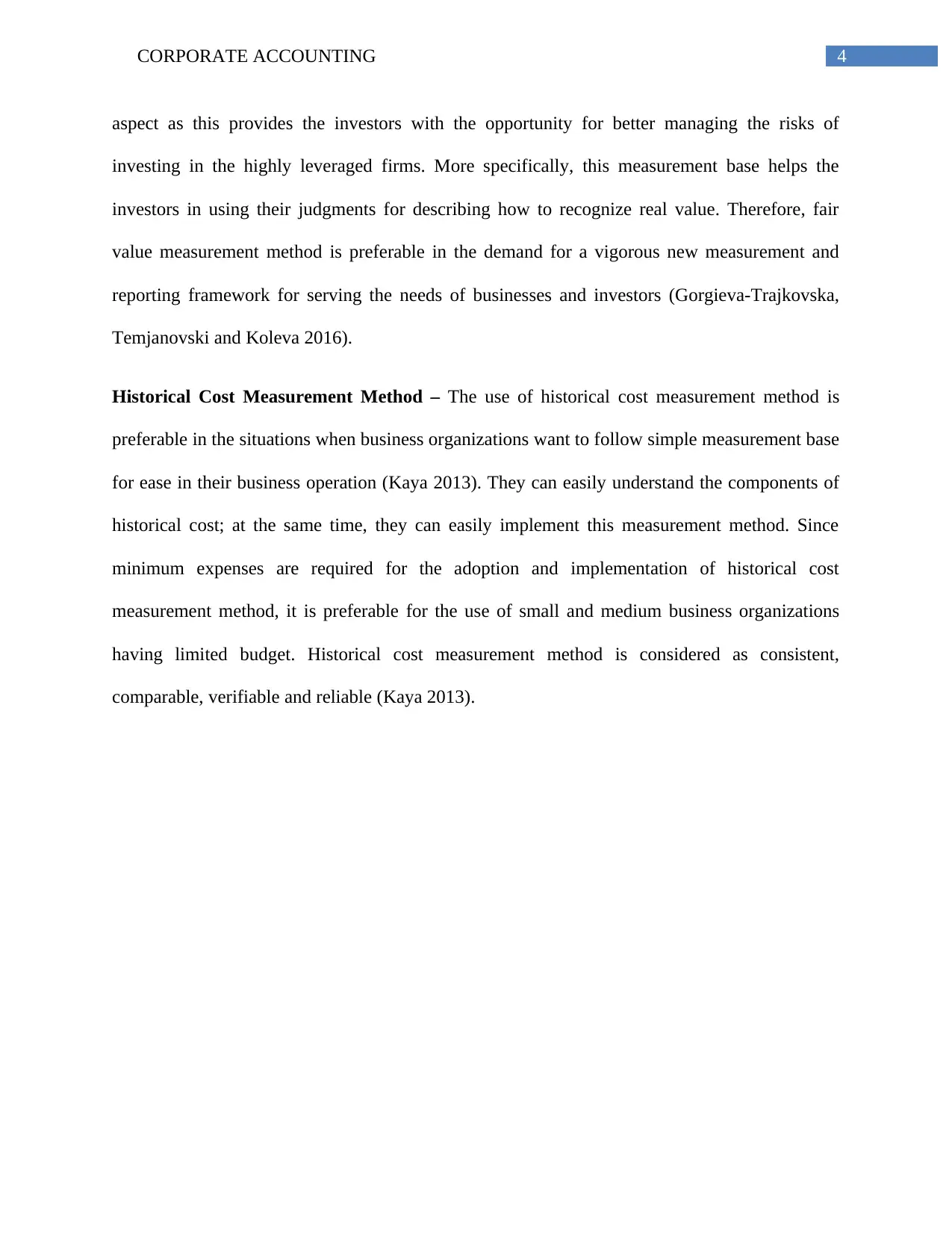
4CORPORATE ACCOUNTING
aspect as this provides the investors with the opportunity for better managing the risks of
investing in the highly leveraged firms. More specifically, this measurement base helps the
investors in using their judgments for describing how to recognize real value. Therefore, fair
value measurement method is preferable in the demand for a vigorous new measurement and
reporting framework for serving the needs of businesses and investors (Gorgieva-Trajkovska,
Temjanovski and Koleva 2016).
Historical Cost Measurement Method – The use of historical cost measurement method is
preferable in the situations when business organizations want to follow simple measurement base
for ease in their business operation (Kaya 2013). They can easily understand the components of
historical cost; at the same time, they can easily implement this measurement method. Since
minimum expenses are required for the adoption and implementation of historical cost
measurement method, it is preferable for the use of small and medium business organizations
having limited budget. Historical cost measurement method is considered as consistent,
comparable, verifiable and reliable (Kaya 2013).
aspect as this provides the investors with the opportunity for better managing the risks of
investing in the highly leveraged firms. More specifically, this measurement base helps the
investors in using their judgments for describing how to recognize real value. Therefore, fair
value measurement method is preferable in the demand for a vigorous new measurement and
reporting framework for serving the needs of businesses and investors (Gorgieva-Trajkovska,
Temjanovski and Koleva 2016).
Historical Cost Measurement Method – The use of historical cost measurement method is
preferable in the situations when business organizations want to follow simple measurement base
for ease in their business operation (Kaya 2013). They can easily understand the components of
historical cost; at the same time, they can easily implement this measurement method. Since
minimum expenses are required for the adoption and implementation of historical cost
measurement method, it is preferable for the use of small and medium business organizations
having limited budget. Historical cost measurement method is considered as consistent,
comparable, verifiable and reliable (Kaya 2013).
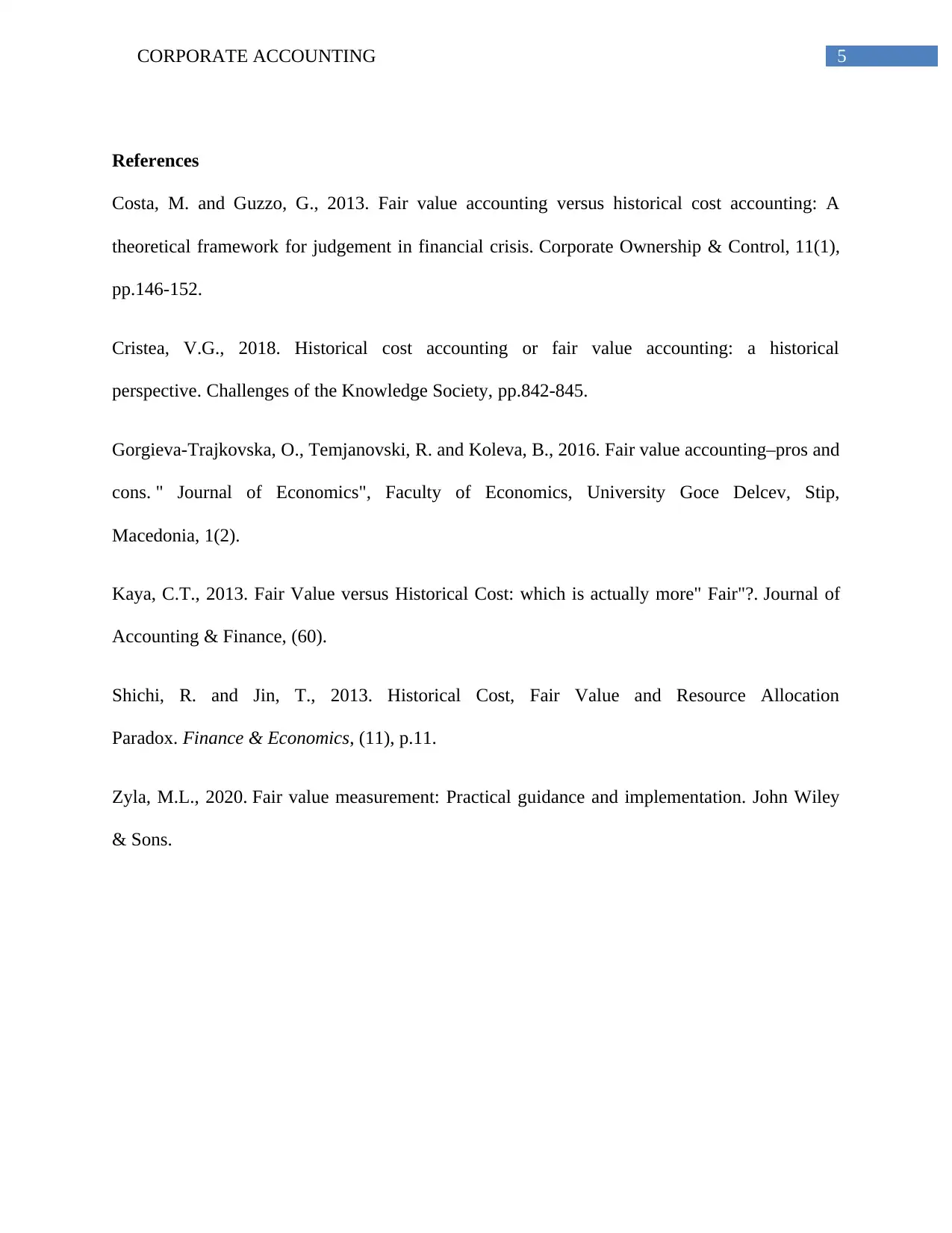
5CORPORATE ACCOUNTING
References
Costa, M. and Guzzo, G., 2013. Fair value accounting versus historical cost accounting: A
theoretical framework for judgement in financial crisis. Corporate Ownership & Control, 11(1),
pp.146-152.
Cristea, V.G., 2018. Historical cost accounting or fair value accounting: a historical
perspective. Challenges of the Knowledge Society, pp.842-845.
Gorgieva-Trajkovska, O., Temjanovski, R. and Koleva, B., 2016. Fair value accounting–pros and
cons. " Journal of Economics", Faculty of Economics, University Goce Delcev, Stip,
Macedonia, 1(2).
Kaya, C.T., 2013. Fair Value versus Historical Cost: which is actually more" Fair"?. Journal of
Accounting & Finance, (60).
Shichi, R. and Jin, T., 2013. Historical Cost, Fair Value and Resource Allocation
Paradox. Finance & Economics, (11), p.11.
Zyla, M.L., 2020. Fair value measurement: Practical guidance and implementation. John Wiley
& Sons.
References
Costa, M. and Guzzo, G., 2013. Fair value accounting versus historical cost accounting: A
theoretical framework for judgement in financial crisis. Corporate Ownership & Control, 11(1),
pp.146-152.
Cristea, V.G., 2018. Historical cost accounting or fair value accounting: a historical
perspective. Challenges of the Knowledge Society, pp.842-845.
Gorgieva-Trajkovska, O., Temjanovski, R. and Koleva, B., 2016. Fair value accounting–pros and
cons. " Journal of Economics", Faculty of Economics, University Goce Delcev, Stip,
Macedonia, 1(2).
Kaya, C.T., 2013. Fair Value versus Historical Cost: which is actually more" Fair"?. Journal of
Accounting & Finance, (60).
Shichi, R. and Jin, T., 2013. Historical Cost, Fair Value and Resource Allocation
Paradox. Finance & Economics, (11), p.11.
Zyla, M.L., 2020. Fair value measurement: Practical guidance and implementation. John Wiley
& Sons.
⊘ This is a preview!⊘
Do you want full access?
Subscribe today to unlock all pages.

Trusted by 1+ million students worldwide
1 out of 6
Related Documents
Your All-in-One AI-Powered Toolkit for Academic Success.
+13062052269
info@desklib.com
Available 24*7 on WhatsApp / Email
![[object Object]](/_next/static/media/star-bottom.7253800d.svg)
Unlock your academic potential
Copyright © 2020–2025 A2Z Services. All Rights Reserved. Developed and managed by ZUCOL.





